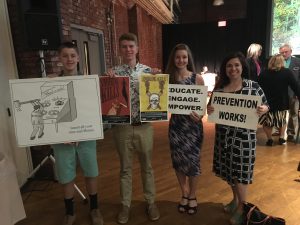
Background and Importance –
Substance misuse is one of the most prevalent and problematic public health issues that poses a wide range of safety and health risks, impacting physical, social and emotional well-being. Substance misuse, involving alcohol, illicit drugs, misuse of prescription drugs, or combinations of all of these behaviors, is associated with a complex range of negative consequences for health and wellbeing of individuals, families and communities. In addition to contributing to both acute and chronic disease and injury, substance abuse is associated with destructive social conditions, including family dysfunction, lower prosperity, domestic violence and crime. Alcohol remains the most prevalent substance misused in the United States and in New Hampshire. Underage drinking, binge drinking, regular heavy drinking and drinking during pregnancy are some forms of alcohol misuse that pose highest risk. Marijuana is the illicit drug most likely to be used by teens and young adults. A majority of people being admitted to treatment programs in NH cite marijuana as a primary or secondary reason for seeking treatment. Marijuana use has a wide range of effects, particularly on cardiopulmonary and mental health, and is also known to be a contributing factor leading to the use of other drugs.
Achievements
On October 26, 2023, CADY hosted a tri-regional Getting to “Y” (GTY) event at the Common Man Inn, in Plymouth. This youth empowerment event was the largest GTY event UP for Learning has seen to date, including in Vermont, the home state where UP for Learning created and launched the GTY program. Over 40 students attended from the Central Region, the Winnipesauke Region, and North Country, where they discussed the Youth Risk Behavior Survey (YRBS). This event was a great success in raising awareness of YRBS data and community risk factors, while engaging students in identifying priorities, brainstorming solutions, and crafting an action plan for success.
During the 2023 Red Ribbon Week, YAAC leaders collaborated with Plymouth State University and the Town of Plymouth to plant bulbs around the traffic circle in recognition of the Plant the Promise Red Ribbon Week Campaign. In the spring (2024), to serve as a reminder of the importance and the beauty of living a drug-free life, the red tulips bloomed and the YAAC wrote social media posts, and a newspaper column to serve as reminders to engage in conversations about the risks of substance use.
This past winter, YAAC leaders were asked to write the youth perspective on vaping for The Partnership@drugfreeNH. YAAC wrote two vaping blogs in January and February 2024, which were featured on The Partnership@drugfreeNH website and social media.
CADY launched a coalition dedicated to providing support and resources to prevent suicide among veterans, active military, and service member families. Through community partnerships and collaboration, the Central Region Veterans Coalition gained traction and is now housed at Whole Village Family Resource Center/Granite United Way. The Veterans Coalition membership is comprised of over 40 Veterans, active EMTs, family members, and community members participating throughout Central NH. There has been positive feedback, and community support for the coalition.
Community Outreach
October 5, 2023, CADY joined forces with Lakes Region Community Services to bring the documentary, “Anxious Nation” to the Flying Monkey in Plymouth. This was a very successful event, with 123 Central region parents, educators and community members attending. Resource tables ranging from Mid-State Health Center and Rise Recovery, to PFLAG and New Futures, were available for browsing. The event also featured the Magnify Voices Art Campaign, supplied by NAMI NH, showcasing NH student art created through a lens of mental health awareness.
The Parent Advisory Council (PAC) hosted the 7th annual Shout Out to Parents event in Plymouth, on November 9, 2023, with Dr. Crystal Collier, PhD, LPC-S, Therapist, Researcher, and Educator, speaking on “Youth Depression & Anxiety: Coping Skills.” 77 parents from the Pemi-Baker, Lin-Wood, and Newfound Region attended.
CADY and Whole Village co-facilitated a Parent Resource Webinar “Parenting for Prevention: Protecting What we Values Most: Our Children,” on March 28, 2024, which brought together local, regional, statewide and national resources for parents, caregivers and professionals to utilize. 40 people attended the live webinar, and the recording and resources were shared widely with school counselors, parents, and kinship caregivers.
2024 marked the convening of the 22nd Annual Prevention Summit with 171 community partners in attendance. This event serves as an opportunity to build awareness of current substance use trends, while celebrating successes. Jon C. DeLena, Associate Administrator of the Drug Enforcement Administration, provided the keynote presentation of “Empowering Youth: Tackling Fentanyl While in a Race to Save Lives.” A live performance of “Triggered” was performed by Michael Stoddard. “Triggered” a one-man show, deals with our nation’s growing drug and alcohol epidemic through the personal journey of an individual in recovery from substance use disorders, including alcohol. Playing over 20 different characters in this 45-minute production, Michael helps audiences better understand the devastating consequences faced by both the individuals with substance use disorders and the people around them who care.
The YAACs put their own creative spin on the Prevention Summit by researching and delivering an engaging and dynamic game show, utilizing the platform Kahoot, to raise awareness about substance misuse in teens. Topics included teen alcohol use, fentanyl, marijuana, and vaping.
Youth voice took the spotlight during the June 2025 Amplify Your Voice NH Student Showcase, a statewide virtual event celebrating student-led prevention efforts through the Getting to “Y” NH initiative. Hosted by Communities for Alcohol- and Drug-Free Youth (CADY), the event featured a powerful live panel of five youth leaders representing three New Hampshire high schools, alongside video submissions from students across the state, offering a glimpse into how youth are transforming data into action.
Diversion
Since October of 2019, 387 young adults have changed their beliefs, attitudes, risk perceptions, and motivations related to alcohol and drug use via their participation in Prime for Life. Prime For Life is an evidence-based motivational prevention, intervention and pretreatment program specifically designed for people who might be making high-risk choices. This program is in collaboration with the NH Liquor Enforcement and reaches college students, and young people charged with alcohol related offenses. For the third year, CADY has partnered with Plymouth State University’s Office of Student Experience to deliver the Prime for Life lesson “Protecting What Matters Most – Your Young Adult’s Health and Safety with Low-Risk Decision Making” during freshman orientation. Approximately 20-25 youth, families, and victims are served each year through CADY’s Restorative Justice Program. This voluntary alternative to court promotes youth resiliency through strengths-based education, restitution, a written apology to the victim(s), and community service. To date, nearly 300 youth have been given a second chance to take responsibility for their actions.
Advocacy
During fall of 2023, CADY’s Executive Director was appointed to the NH State Commission on Cannabis to provide prevention expertise to the review of the proposed state-run cannabis policy. Through this platform, the Commission was educated by numerous medical experts on the risks associated with the legalization of recreational marijuana and high-potency THC. In addition, the Executive Director and Substance Misuse Prevention Coordinator played an integral role in supporting Smart Approaches to Marijuana (SAM) NH media campaign efforts.
In the 2024 Legislative session, CADY participated in preventative efforts on HB1633, relative to legalization of recreational marijuana. This bill would have legalized a state-run cannabis program similar to the NH liquor store/sales. CADY organized, once again, a statewide prevention professional advocacy letter to legislators, educating the NH senate on the dangers of THC and legalization of recreational marijuana on the most vulnerable populations, youth and communities. All Regional Prevention Health Networks were represented on the 2024 prevention professional letter. The YAAC also worked on their Senate Testimony against the passing of HB1633 and testified during the public hearing on April 25, 2024. This bill passed the Senate for the first time in history, narrowly with amendments and was sent to the committee of commerce which did not pass the house vote. Recreational marijuana remains illegal in NH.
Overdose Prevention
CADY continues to partner with Plymouth State University to raise awareness on overdose prevention strategies. In addition to distributing overdose prevention kits, naloxone, and fentanyl test strips, CADY provides technical assistance on the integration of substance misuse prevention into the curriculum for various departments. The Central New Hampshire Community Opioid Response Consortium has also played an instrumental role in outreach through the distribution of 202 naloxone kits, 274 Deterra RX Deactivation bags, and 9 emergency NaloxBoxes.
Challenges
WORKFORCE – The Central NH Region continues to experience a workforce shortage impacted by a limited candidate pool, as well as retention challenges. Multiple community partners are utilizing AmeriCorps members, college interns, and/or volunteers to help fill the gaps. With that said, the region is still in need of qualified public health professionals experienced in the delivery of services across the SUD Continuum of Care. To ensure we maintain the capacity needed to serve the entire region, we will be partnering with Plymouth State University students to assist in the delivery of evidence-based substance misuse prevention curriculum.
Looking Ahead
OUTREACH – CADY will continue school-based and community prevention programming utilizing a regional model. An emphasis will be placed on outreach to the northernmost region, working closely with community partners such as the Bridge Project and the Lin-Wood School district. As a result, Lin-Wood will be invited to join Pemi-Baker and Newfound at the 3rd Central Region Getting to “Y” event where high school students will assess regional and state-wide YRBS results. CADY will support appointed school mentors to ensure youth have the guidance needed to implement identified projects.
Building off the success of the Pemi-Baker Parent Advisory Council (PAC), CADY launched the Central Region PAC (bringing all three regions from Central NH together for regional outreach efforts). This regional PAC will allow for the coordination of outreach and education efforts across districts, increasing the number of engaged parents. The PAC also launched a Central Region Parent newsletter which will be distributed via Facebook, through schools and other outreach methods. In addition, we are focused on providing parent/caregiver support on engaging youth in prevention conversations targeting THC edibles, vaping, and counterfeit pills.
CADY has collaborated with Whole Village Family Resource Center and Lakes Region Community Services to bring a new Parent Resource to the region, Parent Cafes. CADY has also begun initial planning to collaborate with multiple partners, including Voices Against Violence, to raise awareness of co-occurring issues in Central NH.
FINDWELLNH.ORG – While we will continue to monitor and curate reliable content to build resilience within Central New Hampshire communities, with additional resources, an opportunity exists to grow the database to include resources to align with each of the Regional Public Health Networks. This would require funds to support upload and monitoring of regional assets, management of social media and marketing efforts, and web programming support to ensure seamless functionality.
Prime for Life – There have been 45 Prime for Life participants registered for the virtual class from 7/23 – 6/24, not including an in-person class that was delivered to students from Waterville Academy in October 2023, which included 29 students and staff. Moving forward, we will be continuing our partnership delivering PFL with PSU incoming Freshmen Orientation, along with a new partnership with PSU School Counseling Department. This will allow CADY to educate PSU counseling department students about Prime for Life in fall 2024. CADY will also present to the NH Chief Association in August 2024 and will be scheduling a presentation with NH Liquor Enforcement to do a full awareness training for Liquor Enforcement officers. We also plan to recruit new certified PFL instructors.
